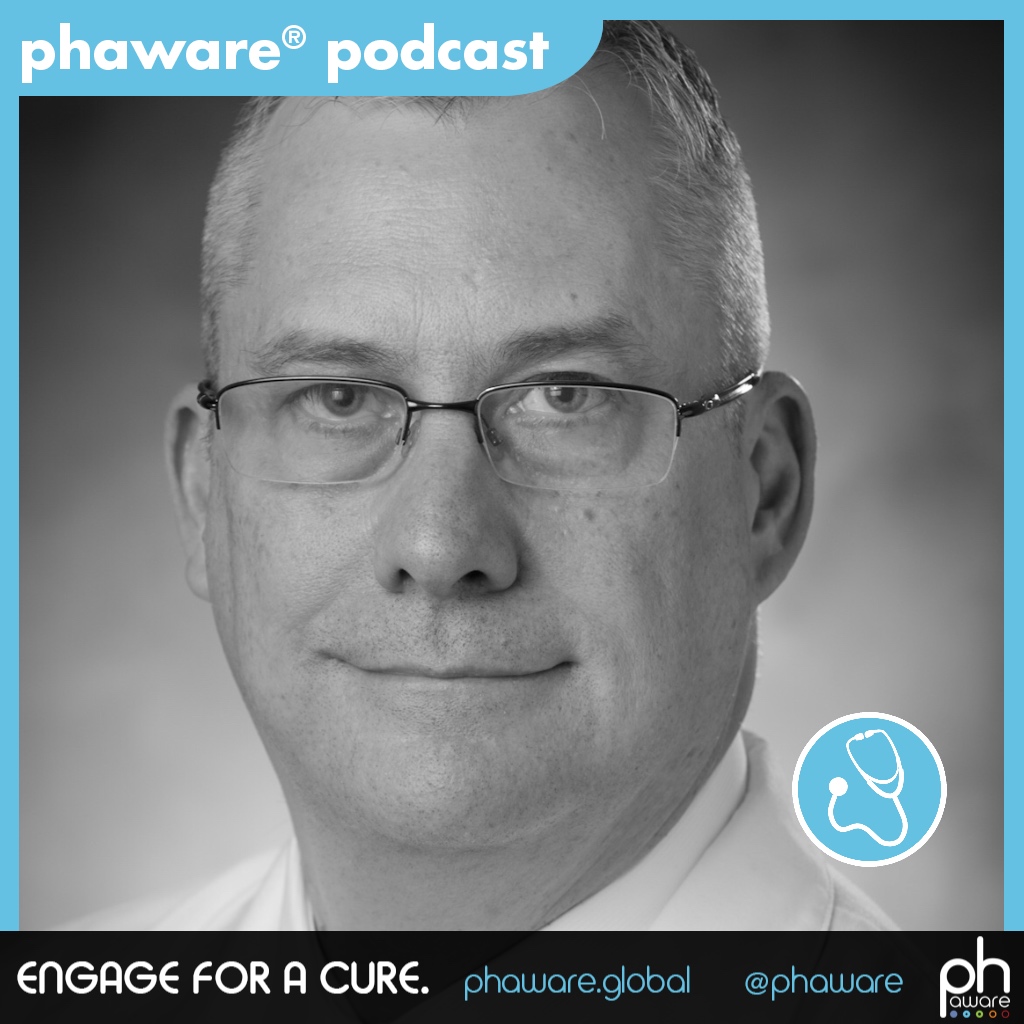Phaware Podcast: Victor Test, MD (Part 2 of 2)

This podcast series, created and produced by phaware, is being offered as a regular guest feature on Pulmonary Hypertension News to bring the voices and life experiences of PH patients, family members, caregivers, healthcare specialists, and others to our readers. You may listen to the podcast directly, or read it via the transcript that runs below.
I’m Aware That I’m Rare: Victor Test, MD (Part 2 of 2)
The phaware® interview (Episode 100)
Victor J. Test, MD is a professor of medicine at Duke University School of Medicine. He treats patients with pulmonary vascular diseases including high blood pressure of the lungs (pulmonary hypertension) and unresolved blood clots in the lungs (pulmonary embolism). His research specifically focuses on chronic thromboembolic pulmonary hypertension. In this episode, Dr. Test discusses some of the tests that are used to assess a patient’s exercise capacity, and how it relates to the management of patients with pulmonary hypertension.
I’m Victor Test. I am the director of the Pulmonary Vascular Disease Center at Duke University. I have an interest in unexplained shortness of breath, chronic thromboembolic pulmonary hypertension (CTEPH), pulmonary embolism, and pulmonary vascular diseases of all sorts.
interest in unexplained shortness of breath, chronic thromboembolic pulmonary hypertension (CTEPH), pulmonary embolism, and pulmonary vascular diseases of all sorts.
Today, I would like to talk with you a little bit about some of the tests that we’ve used to assess a patient’s exercise capacity, and how it relates to the management of patients with pulmonary hypertension.
One of the other areas that we often do, when we’re testing people for pulmonary hypertension, is to test them to see what their exercise capacities are, and that’s important. I think, for most patients, you can sort of understand that; patients who can do more will tend to do better.
The simplest of those tests is called a six-minute walk. It sounds really simple. Right? You walk for six minutes. We see how far you go. We see what your oxygen levels do, and what your heart rate does, and sometimes we measure your blood pressure before and after. That all seems pretty simple, but actually, a six-minute walk is more complicated than that. It’s a patient-driven test. When the patient’s doing the test, they’re doing the best they can. We’re not trying to encourage them, or drive them, or move them forward, and actually, if the test isn’t done exactly the way that it’s prescribed, it’s very hard to interpret what the meaning is from a place to place, or time to time.
We have to use exactly the right length of the track to measure the six-minute walk, and we also have to say the right things to the patient throughout. If we, for example, say to you, “Walk as fast as you can,” or, “Walk as far as you can,” it changes the outcome, so we have to be really careful how we do that. It’s a really important test for us, because we can do it every time you come in to the doctor, and it gives us a measure of how you’re doing, and how you do, compared to what you were doing before. It’s cheap, it’s relatively easy to do, and because of that, it’s a very, very important test for us.
It’s interesting, because when I was in residency and fellowship training, patients with COPD and pulmonary fibrosis would sometimes get a 12-minute walk. The 12-minute walk has all but disappeared. The reason the six-minute walk was chosen, is because when the first medications were being tested for pulmonary hypertension, there was a requirement that we show that patients could actually do more. In the early days of testing for pulmonary hypertension, a lot of the patients were very severely impaired, so some of the exercise tests, and things that we would measure to see how patients were doing, whether they were improving or not, were very difficult for them. In the original trial, which was in 1996, for our medication to help patients with pulmonary hypertension that was successful, the six-minute walk was the test that was chosen.
I think, in part, it was chosen because six minutes was a relatively reasonable period of time to walk, and it was just picked, in a way, kind of arbitrarily. From that, the six-minute walk then extended use in every clinical trial for pulmonary hypertension medicines, to judge the effect on exercise capacity, and it also then sort of branched into other diseases, like pulmonary fibrosis and COPD.
You virtually never see a 12-minute walk anymore. I think there are many reasons for that. One of them is that it’s pretty easy to do. You know? You have to have a hallway of a certain length. You have to have an oximeter, and a stopwatch, and a score sheet to keep track of how the patient’s doing. It can be done practically anywhere. If you compare it to other kinds of exercise studies, like what we call the cardiopulmonary exercise test, you have to have very specialized equipment, and that’s not available everywhere, so the six-minute walk can be done in anyone’s office, assuming they have the hallway of the appropriate length.
Because of that, it’s sort of extended out and is the main test we use to follow a patient’s exercise in the majority of centers, both academic and in private practice. Because it’s been used in every pulmonary hypertension trial, as a reflection of exercise, it also has sort of become part of our thinking, and it’s been associated with outcomes as well, although there’s a lot of debate about that from time to time. Generally, we know that patients who do better on their six-minute walk tend to do better than patients who don’t.
One of the other tests that can be done sometimes is a cardiopulmonary exercise test, which is a much more complicated test, but it gives us really definitive information about how much work a patient can do, and it also tells us about the relative interaction between the lungs and the heart. When you do a cardiopulmonary exercise study, most people do it on a bicycle or on a treadmill, and we put a mouthpiece in, so that we can measure how much air you move in and out, and then we also measure your pulse and your blood pressure. We can actually see exactly what you’re capable of, and from that, separate out different things, which tell us about the cause of shortness of breath, about how much work a patient can do, and it also gives us important evidence about prognosis.
Occasionally, we’ll even do that with a right heart catheterization in place, to help us figure out, in patients with more complicated disease, what the exact cause of their shortness of breath is. The exercise testing is very, very important. A lot of these tests are used to make a diagnosis, but many of them, we also use to follow patients long term.
For most patients, if I could say one thing that would be most important to you, as you’re being evaluated for pulmonary hypertension, is you want to make sure that you get a thorough evaluation, and not be labeled on the basis of an echocardiogram or a single test.
I’m Victor Test, and I’m Aware That I’m Rare.
EVERYBODY HAS A STORY. WHAT’S YOURS?
Phaware global association wants to share your pulmonary hypertension story with their engaged global audience. Whether you are a patient, caregiver, or medical professional, they are enlisting PH community members from around the world. Visit www.phawarepodcast.libsyn.com/contact to share your story and to be considered for a future episode. Never miss an episode with the phaware® podcast app. Learn more about pulmonary hypertension at www.phaware.global. #phaware
***
Note: Pulmonary Hypertension News is strictly a news and information website about the disease. It does not provide medical advice, diagnosis, or treatment. This content is not intended to be a substitute for professional medical advice, diagnosis, or treatment. Always seek the advice of your physician or other qualified health provider with any questions you may have regarding a medical condition. Never disregard professional medical advice or delay in seeking it because of something you have read on this website. The opinions expressed in this column are not those of Pulmonary Hypertension News or its parent company, Bionews Services, and are intended to spark discussion about issues pertaining to pulmonary hypertension.










Leave a comment
Fill in the required fields to post. Your email address will not be published.